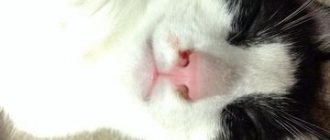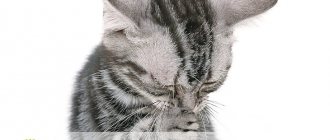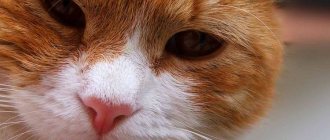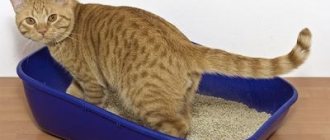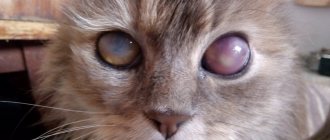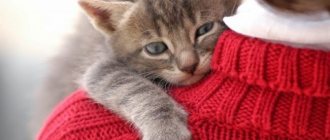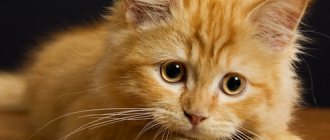( 2 votes, rating: 1.00 out of 5)
5589564
05/29/2021 owner reviews
Have you noticed that your cat's back twitches after a few seconds of petting it? This is a common reaction in cats that may seem normal, but there is cause for concern if it happens frequently. Read on and let's unravel the truth beyond the back twitch phenomenon.
- Causes 1. It may be due to feline hyperesthesia syndrome
- 2. It may be due to the sensitive layer of muscle located on the cat's back.
- 3. Your petting may overstimulate your cat.
Mechanism of seizures
Convulsive twitching of the paws or the whole body is always frightening.
Especially if you don’t know the nature of this phenomenon. This behavior is not typical for animals. Seizures are a dangerous pathology that is not an independent disease.
Muscle spasms are a sign that some organ or system of the animal has malfunctioned and affected the functioning of the brain.
How does this happen
By nature, cats have tissues and ligaments of the muscular system that are quite elastic. That’s why they manage to change so quickly from a relaxed state to an active one and vice versa. This transition is so smooth that it is difficult to notice from the outside.
But convulsions immediately catch the eye. At the same time, the cat not only twitches the body or individual areas - muscle cramps are accompanied by painful spasms.
Twitching can be single or repeated at regular intervals. But spasms always come suddenly and manifest themselves in different ways.
Types of seizures in cats
| Type | How it manifests itself |
| Convulsive | Mild twitching or muscle contractions are observed. The pet responds adequately to the owner |
| Tonic | Short-term, but repeated slow muscle contractions with a certain periodicity. The cat behaves restlessly, not just meows, but howls |
| Clonic | Contractions alternate with relaxation. The cyclicity is about 30-120 seconds. During convulsions, the pet falls on its side, and in the intervals between them makes attempts to move |
| Epileptic | The cat's muscles are constantly tense, he himself is in an unconscious state, often with his eyes open. If relaxation occurs, it lasts a few seconds. |
The last type of seizure is the most dangerous, as it usually ends in the death of the animal..
But even convulsive twitching does not go unnoticed for the pet. Therefore, it is important, with the help of a specialist, to determine the cause that provoked the seizures and try to eliminate it.
Why do cats snore?
In order to give correct explanations, we will touch on the anatomical structure of cats, the basics of which any owner who respects his animal should know.
The picture clearly shows how long the cat’s trachea is. Through the trachea, air enters the cat's lungs, and through it it is expelled back. In a normal state, the number of inhalations and exhalations by a cat is 17-20. A very deep breath and a very long exhale! Air is passed through the vestibule of the trachea - the larynx.
But our cats, cats and kittens do not know how to growl - the hyoid is rigidly embedded in the larynx. But our pets can purr, forcefully pushing air through this natural bony barrier. They push air as they inhale, push it as they exhale, and therefore their purring process is continuous as long as the cat keeps the larynx in a relaxed state.
Kittens begin to make these sweet sounds as early as 5-7 days after birth, as soon as their little larynx begins to harden.
This is the first reason for snoring.
Do you know that pugs snore always and everywhere? The reason for this is the brachycephalic structure of the muzzle. If your cat has the same shortened nasal passages and unnaturally altered “facial” bones, then snoring for them is a natural, standard condition, because the air moves along an anomalous trajectory. They snore even while they are awake, but during sleep, when they relax, the snoring is especially pronounced.
Snoring can also occur in the most unimaginable positions that a cat takes during sleep. This position may seem comfortable to the cat, but it blocks the natural flow of air to the lungs - disrupts their circulation. The body reacts by drawing in more air and releasing carbon dioxide back. Result: we snore, we’re shaking!
We are not talking about obesity yet, but your cat’s “legs” have already become plump, the ribs are difficult to feel under the layer of subcutaneous fat, and the scruff of the neck is almost equal in width to the butt.
If until recently your funny kitten was cheerful and cheerful, but today he has a runny nose, drooling, sneezing, diarrhea, lack of appetite and snoring, then take him by the paw and take him to Aibolit. This one sign is enough to start seeing a doctor and start proper timely treatment, which will lead to the recovery of your naughty boy.
The cause of “fading” can be anything, from helminthic infestation and diseases of the gums and teeth, to serious diseases of the heart and other internal organs.
Having dealt with the main causes of snoring, let's try to find out why your cat twitches in its sleep, runs somewhere, shudders, twitches and even fights.
Causes of convulsions
All types of muscle contractions indicate that there are many factors that provoke symptoms.
To make it easier to make a diagnosis and carry out targeted treatment, the predetermining causes are divided into groups:
factors associated with brain dysfunction;- reasons that led to disruptions in the metabolic processes of the cat’s body;
- intoxication.
These are based groups that include entire lists of diseases in which sudden convulsions and seizures are possible.
Each cause of muscle contractions should be considered in detail so that you know what you have to face.
Forms
There is no special classification of the disease. There are several separate forms depending on the mechanism of occurrence:
- radicular: associated with irritation of the spinal cord roots at the point of their exit from the spinal column;
- reflex: associated with overstrain of muscle fibers at the site of the nerve passage.
There is also a classification of neuralgia depending on:
- causes: primary (associated with damage or inflammation of the nerve itself) and secondary (due to other diseases);
- localization: unilateral and bilateral;
- course of the disease: acute and chronic.
With brain damage
Pathologies affecting this organ are the most dangerous. Defeat can be caused by both external factors and internal processes.
Causes
| Disease | Peculiarities |
| Tick-borne encephalitis | When an ixoid tick bites, an infection enters the cat's body with the insect's saliva, causing the disease. Characteristic signs other than seizures:
|
| Hypoxia | Oxygen starvation can occur for a number of reasons, but in any case it leads to damage to brain tissue. At first, the symptoms are mild, and the seizures are so short-lived that the owner may simply not notice them. As the pathology develops, the number of convulsions and their duration increase. Hypoxia can be suspected by suddenly appearing shortness of breath, fainting, or cyanosis of the mucous membranes. |
| Rabies | Not just dangerous - a fatal disease caused by Babes Negri bodies. The animal's hind legs twitch first, then its limbs become paralyzed. While the cat is able to move, it shows strong aggression. The disease develops rapidly. Spasms pass from the body muscles to the respiratory muscles, and the animal dies from suffocation |
| Tumors | The initial stage of oncology has no obvious symptoms. They will appear when the tumor, growing, begins to put pressure on important areas of the brain. The animal's behavior changes: the cat becomes aggressive, loses orientation - constantly bumps into walls, objects, and monotonously circles in one place. The disease is often accompanied by convulsive seizures |
| Hydrocephalus | The cause is disruption of the outflow of fluid from the brain. The pathology is congenital and can be detected at an early stage. A kitten suffering from hydrocephalus has a larger skull volume than healthy babies, and it lags behind its brothers in development. The disease manifests itself as clonic convulsions, the first signs of which can be noticed at 2 months of age. The rapid development of pathology leads to death |
| Hematomas, injuries | Damage to the skull is accompanied by profuse vomiting. With severe injuries, loss of consciousness, paralysis of a group of muscles and twitching of those that hold the eyeballs are possible. |
Even an unbalanced diet, which provokes the development of vitamin deficiency, can cause brain damage.
In particular, this concerns vitamin B1 (thiamine), which is necessary for the smooth functioning of systems. The initial stage is manifested by trembling of the limbs; with severe deficiency, convulsions are observed.
The cat's tail and skin on its back twitch - why and what does this mean?
Cat owners sometimes observe the following picture: the pet's tail twitches, as if he is marking territory, and the skin on his back shakes, as if he is trembling in this particular part of the body. This phenomenon may have physiological and pathological causes. Regardless of what exactly led to the twitching of the tail and skin, the four-legged pet in this situation requires the help of the owner.
The animal has fleas or other ectoparasites
If an adult cat or kitten twitches its tail, while the skin on its back trembles, it may be overcome by ectoparasites (those that parasitize not under the skin, but on its surface): fleas, lice eaters, ticks. In addition to these symptoms, external parasites manifest themselves as follows:
- bite marks on the body in the form of small red dots;
- unbearable itching in the affected areas;
- constant scratching in an attempt to somehow relieve the itching from the bites;
- jumping black dots, grains that look like dirt;
- deterioration of the coat (loss, loss of shine, fragility);
- sleep disturbance – due to constant itching, the cat hardly sleeps;
- complete or partial lack of appetite;
- anxiety, lack of interest in games, apathy;
- ulceration of the affected skin, scabs;
- reduction in body weight.
Having discovered ectoparasites in your pet, you must immediately begin treatment. Ignoring the fact of their parasitism on the cat’s body is fraught with serious consequences for his health.
The cat is nervous
Is your pet shaking its tail? This may be a sign of anxiety. Don't confuse anxiety with stress. Both of these conditions are associated with negative emotions, but in the first case they are not as pronounced as in the second. Anything can cause anxiety in a cat. She may get nervous because of a large crowd of people in the house, the appearance of a stranger in it, the long absence of the owner, etc.
In order for your pet to calm down, you need to take him in your arms, caress him, and talk to him.
It is best to try to switch the animal's attention to something else, such as a game. Having an active and fun time, it will forget about worries
Pet wants to go to the toilet
If an animal's back twitches closer to its tail, it most likely wants to go to the toilet. Observing cats, you can notice that their skin in this area begins to tremble before bowel movement occurs. This is normal.
This situation requires the intervention of the owner if the trembling does not end with defecation, and the pet becomes restless, meows pitifully, and refuses to eat. This behavior indicates constipation. If your four-legged pet does not defecate for several days in a row, it is time to take measures to empty its intestines of feces.
The cat was bitten by an insect on the back or tail (mosquito, wasp, etc.)
Is your pet twitching its tail, the skin on its back shaking, while it is worried about something or meowing pitifully? Perhaps he was bitten in this place by a wasp, bee, mosquito or horsefly. To help your pet cope with itching and pain, you must first make sure that there is no insect sting left at the site of the bite. If it is detected, you need to carefully remove the foreign body with disinfected tweezers.
Wasp and bee stings are not as harmless as they might seem at first glance. Its danger is that the cat may develop an allergic reaction to bee and wasp saliva. If you discover that your cat has been bitten by an insect, you need to give him an antihistamine and carefully monitor his condition. If suspicious symptoms appear, the pet should be taken to the nearest veterinary hospital as quickly as possible. To eliminate pain and itching, you need to anoint the bite site with antipruritic ointment.
The cat's back itches due to allergies
This problem may be caused by an allergic reaction. Allergies in cats can be caused by pollen from flowering plants, dust, the owner's perfume, food, medications, substances secreted by ectoparasites, litter for the litter box, etc. The increased sensitivity of the cat's body to allergens is manifested by a number of symptoms common to all irritants:
- skin rashes;
- deterioration of hair condition (loss, fragility);
- unbearable itching;
- bloody wounds due to scratching;
- nasal congestion;
- copious clear nasal discharge;
- sneeze;
- excessive salivation;
- peeling of the paws, especially in the areas between the toes;
- breathing problems;
- indigestion.
Allergies are not as harmless as they might seem. An allergic reaction can lead to a fatal condition - anaphylactic shock. To prevent this from happening, you need to start eliminating the problem immediately after the listed symptoms appear in your pet.
Metabolic disorders
Failures in the functioning of internal systems disrupt metabolism and the rhythm of metabolic processes. This leads to an imbalance in the nervous system, and impulses are sent to the muscles “incorrectly,” which manifests itself in convulsions.
Metabolism-related diseases
| Name | Peculiarities |
| Eclampsia | It is observed during the period of gestation of kittens, at birth and feeding. A convulsive state develops against the background of a sharp decrease in the level of calcium in the blood and is accompanied by severe pain. In the initial stage, convulsive twitching is observed in the hind limbs. As the attacks progress, they become more frequent and affect the entire body. |
| Kidney failure | There are many factors that provoke this disease, from common infections to autoimmune pathologies. Failure of the kidneys interferes with the removal of toxins from the body. As a result, brain tissue is damaged. |
| Hypoglycemia | Blood glucose levels drop sharply. Convulsive attacks are accompanied by severe pain, causing the animal to writhe and scream loudly. This condition is similar to epileptic seizures |
| Intoxication | Toxic substances that enter a cat’s body have a negative effect on the nervous system. In mild cases, this provokes stool upset. In severe situations, intestinal bleeding is added to diarrhea. The cat is vomiting and writhing in convulsions |
Any disruption of metabolic processes if assistance is not provided in a timely manner will lead to the death of the pet.
Old age can also be included in this group of pathologies. In the body of old cats, degenerative processes occur that affect almost all organs, but the brain is the first to suffer.
Involuntary muscle twitching may be pre-death convulsions.
Other reasons
There are other factors that do not fit into the structure of known groups. They are also dangerous and can cause death.
Postoperative period
Surgical interventions are accompanied by the administration of painkillers, anesthesia and other medications to the animal. If the operation was performed incorrectly or the dosage was incorrectly selected, the body may react to this with convulsions.
When prescribing medications, the doctor must take into account their individual intolerance.
Epilepsy
A systemic disease associated with changes in brain activity is always difficult, with severe, painful seizures and can result in the death of the pet at any time.
The pathology can be hereditary or develops against the background of trauma, inflammation of the membranes of the brain, or cancer.
Stress
Convulsive contractions are short-term in nature, accompanied by aggressive behavior and lack of appetite. This is due to strong stimulation of the nervous system after experiencing emotional shocks.
A cat can be stressed by bathing, moving, or the arrival of a new animal or small child in the house. In uncastrated pets, seizures may begin due to unsatisfied sexual instinct.
How a cat owner can help a veterinarian
The more information a doctor receives about his patient, the sooner he will be able to make a diagnosis and begin treatment.
It is important for the doctor how the seizure occurred, what the nature of the seizures was. If the cat had seizures not for the first time, then when did they occur during sleep or during a period of excitement?
Was the pet treated for any diseases and with what medications, did he have any cases of poisoning. Even the animal’s diet and its food preferences are important. If his diet includes raw meat and fish, then the veterinarian should definitely know about it.
After prescribing treatment, you must carefully follow the instructions, and if side effects occur, immediately contact a specialist again.
What symptoms should you be wary of?
Any deviation in the animal’s usual behavior should be alarming.
To prevent seizures from becoming a surprise, you need to pay attention to the accompanying signs:
- uncontrolled urination;
- involuntary defecation;
- dilated pupils;
- flow of saliva or foam from the mouth.
It happens that an animal shows aggression, does not respond to the owner’s voice, and does not allow itself to be touched. This behavior is due to the fact that the cat is frightened by a sudden attack and severe pain.
How to help a cat during an attack
The first thing to remember when watching an animal go through convulsions is that the seizure will eventually end; it usually lasts from a few seconds to 10 minutes, if, of course, you seek treatment in time. If your cat's seizures last longer than 15 minutes, call your veterinarian immediately.
To alleviate the animal's suffering, use this guide:
- Observe the behavior of your pet - if it is aggressive, do not touch the fluffy one, leave it alone and wait until the attack ends.
- If the cat is in itself, carefully wrap it in a blanket, it will keep it warm and help prevent self-inflicted injuries. Just in case, put on thick gloves on your hands; in agony, the animal may bite the owner.
- Do not try to restrain the movement of the hind legs or remove drool from the mouth. Firstly, it will be very painful for the purr, and secondly, you can injure it even more.
- Do not go to another room - the animal needs support at least as your presence. If it is unpleasant and painful to look at a cat in pain, turn away.
- When the attack is over, do not leave the frightened and excited animal alone - caress the purr. A feature of the animal’s behavior after an attack may be a temporary loss of orientation in its home.
https://www.youtube.com/watch?v=uiJJbbpA_4s
First aid: owner actions
In such situations, a person’s self-control plays an important role. Timely measures taken will help save the life of a pet:
- During an attack, the cat must be carefully laid on a flat surface, which is covered with oilcloth or rags. At the same time, you cannot forcibly hold it, so as not to provoke unnecessary stress. You should not unclench your jaws, so as not to injure the animal.
During an attack, it is recommended to administer an anticonvulsant and analgesic to your pet. They do this by injection, and not by mouth: convulsions that seize the muscles of the larynx will not allow the cat to swallow the medicine, and it will simply choke.- A light massage will help ease the spasm. It is carried out on areas of the body affected by convulsions.
Even a small isolated attack is already a reason to urgently take your pet for examination. Convulsive muscle contractions don’t just happen. There needs to be a reason for this, and each of them is dangerous.
Treatment: basic measures
Therapy for convulsive states is necessary in any case, but it is prescribed only after examining the animal. Therefore, all treatment is divided into stages.
Step one - diagnosis
The doctor asks the owner how the attacks manifested themselves and what they were accompanied by. When compiling an anamnesis, it is important to know what the cat ate the day before, how it behaved, and whether there were stressful situations or injuries.
Blood and urine tests are taken from the animal. The cat is sent for hardware examination (ultrasound, MRI). Only after collecting all the results does the doctor move on to the next stage.
Step two - choosing treatment tactics
In each specific case, an individual course of therapy is selected. First of all, it is necessary to act on the factor that provoked the cat’s seizures. Often an epileptic attack is stopped with Promidon.
Symptomatic treatment includes the following:
- prescription of analgesics;
- antiemetics;
- solutions that prevent dehydration;
- vitamin complex.
You can quickly eliminate cramps with Pagliferal or Phenobarbital.
But these injections are done only in a clinic under the supervision of a doctor, since the drugs are toxic and an overdose cannot be allowed.
Preventive measures
Prevention will help you avoid problems related to your pet’s health:
- diet with the selection of balanced feeds;
immunization and deworming of the animal;- regular treatment against parasites;
- timely treatment of infectious diseases.
Preventive visits to the veterinarian 1-2 times a year will help to promptly identify and eliminate diseases of internal organs and systems.


